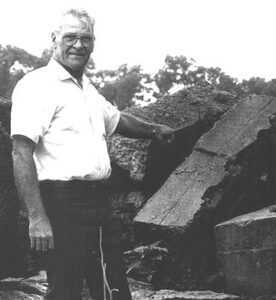Unexpected Visitor Was Giles Oil Driller in 1947
by Johnny Phelps, GILES PATHS, The Giles Free Press
Thursday, June 25, 1987
 -staff photo by Johnny Phelps
-staff photo by Johnny Phelps
Tommy Horne points to the remains of Giles County’s first oil well dug in 1947 at a cost of $200,000.
Two weeks ago, I was going through old photos and newspapers upstairs in the Pulaski Publishing building. I came across several photos of oil wells, and written on the back of one was “March 1947.” J. H. Smith, the late editor of The Pulaski Citizen, had written: “The derrick construction workers are digging holes to pour concrete for an oil well located on the Beeler farm at Campbellsville.”
This was most interesting, so I began searching through all the material I could find on oil wells from 1947 and 1948. It was difficult, but I gathered what I could, and at 9 a.m. Monday, I began to write Giles Paths number 128. About 30 minutes later, Jo Goolsby, the secretary at Pulaski Publishing, called me out front to see if I could help a visitor. Well, I didn’t want to go, but duty called.
“I’m looking for some old papers or anything about Giles County,” the man said. “My name is Tommy Horne, and I come back to Giles County once a year to visit. That Giles Paths series is what I would like to see,” he said.
Well, I was impressed. After all, this guy lived in Lafayette, La. I invited him back to my office and began searching through the files for some old Giles Paths papers. I asked him why the interest in Giles County.
“I’m not a native, but I spent about five months here in 1947,” he said. “I was an oil driller. Can you believe that?” he asked with a smile.
I turned sharply and asked where. “Oh, it was up around Campbellsville on the Beeler farm,” was his answer.
I asked him if he was serious while grabbing for old photos. He was just as shocked as I was to see them.
“That’s me right there,” he said.
Talk about luck. That’s the way it happened.
It was true that Tommy Horne came to Giles County to drill oil. He stayed at the Hart House across from the Pulaski Electric System. His stay was only five months, but his fond memories have certainly grown over the last 40 years. Mr. Horne had his meals at Rank’s Cafe across the street. He had noticed the young, good-looking waitress, Addie Ward. A couple of months later, her name was changed to Horne. On June 21, 1987, 40 years later, the couple would be back for their annual visit. Accompanying them was 88-year-old Duncan Ward of Knox Hollow, the father of the bride.
The June 9, 1948, issue of The Pulaski Citizen had a headline reading: “Oil Interest Revived, California Company Renews Land Leases, Approximately 80,000 Acres Under Rental at 10 Cents Per Acre.”
The acquisition of the land began in August 1946 when a crew from Corsicana, Texas, started securing leases that would remain in effect for 10 years. The company also had the privilege of extending its interest to 40,000 acres in the Campbellsville area and 10,000 in the southern part of the county.
In March 1947, Tommy Horne and his crew arrived at the E. W. Beeler farm in Campbellsville. It would become the site of Giles County’s first oil well. Actual drilling commenced in April.
The well was closed in August 1947 after reaching granite at 5,000 feet, following about four months of drilling by the California company.
“I remember they told us after we reached granite there was no use trying to go any further,” Horne recalled. “There just wasn’t a bit invented at that time that would go through granite, because it was considered the base of the earth.”
Tommy Horne and I drove the 14 miles from Pulaski to the Campbellsville area to visit the site of Giles County’s first oil well, the one where he spent five months as a derrick worker.
We stopped at Fayne Ingram’s farm and began searching for the remains of the oil well. We spotted several concrete blocks in a barn lot, and Tommy was quick to say, “That’s it. It’s hard to believe that’s all that’s left of the $200,000 it cost to drill that 5,000 feet.”
“I remember making $1.20 an hour, and believe me, in 1947 that was big money. There were 21 of us working at the Campbellsville well, three shifts, 24 hours a day. It took us about five months to drill 5,000 feet. Had we been drilling in Louisiana, we could’ve gone 5,000 feet in two days,” Horne explained.
“We did hit a pocket of oil here at about 3,000 feet, but we never could get it capped. I remember it was the only well we dug using clear spring water. We pumped it from the back of a store in Campbellsville,” he continued.
“I also remember well the school kids at Campbellsville and other people who stayed up there a lot to watch us drill. We finally had to post the land.”
“Oh yes, Giles County was such a beautiful sight to me. When we rode out there the first day to begin drilling, we drove up Highway 31 toward Columbia. We were in a truck. We turned off and went through the Milky Way Farm. We were shocked at the beauty of this place and all those white fences and beautiful barns. It was just unbelievable to us.”
“We were all sad when we had to leave Giles County, but after we didn’t find oil, we had to go to other areas. Even though there were about six more wells drilled over the next two years, we didn’t drill any of them.”
Tommy Horne and I drove back to The Pulaski Citizen, and I began searching for more stories on other oil wells. There were plenty.
- July 14, 1948: “Oil interests are busy in Giles County, with 6,488 additional acres, including Crescent View Farms, 844 acres.”
- July 21, 1948: “Oil drilling was to get underway on the Earl C. Zuccarello farm near Campbellsville.” This site was only three miles from the location of the first well on the Beeler farm. Two wells were drilled by the California company, but no oil was found.
- December 15, 1948: The Nashville Banner headline read: “Drilling to begin in Richland Creek area.” The first well was opened on the Mary Cosby farm, two miles south of Pulaski. It was the fourth such well, and again, no oil was found.
In the late 1950s, oil drilling took place on the Guy Phillips farm south of Pulaski. Movie actor Robert Mitchum made a couple of trips to oversee land he leased for oil exploration. Once again, no luck.
In recent years, oil has been sought in the Cedar Grove area, continuing the search since February 1947 for some of the black gold, but with no success.
However, driller Tommy Horne was proud to be part of the oil search in Giles County. And his life has been filled with 40 years of happiness, as he struck it rich not in oil, but in love when he found his wife, Addie Ward.
